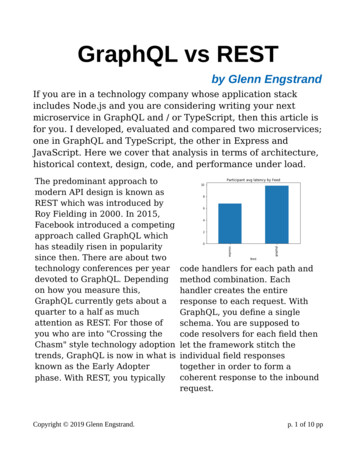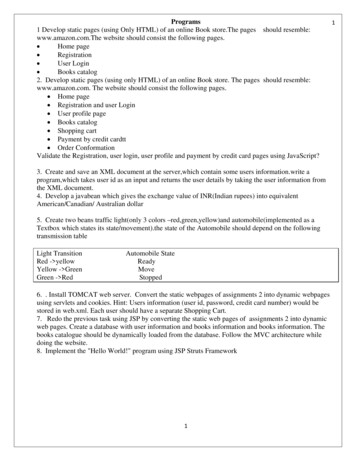
Transcription
Introduction to GraphQLJuly 13, 2018MidDevConBaltimore, MD@ShopifyDevshttp://developers.shopify.com
Welcome! My name isEvan
Shout out: MLH Localhost Special thanks to Major League Hacking, who created these workshopmaterialsMajor League Hacking (MLH) powers over 200 weekend-long inventioncompetitions that inspire innovation, cultivate communities and teachcomputer science skills to more than 65,000 students around the world.Localhost is their “between hackathon” workshop offeringhttps://mlh.io/@MLHacks
What will you learn today?
Why does this matter?
Table of contents1. Introduction to APIs and GraphQL
Why are APIs important?Example: Google APIs
What is REST?Representational State Transfer.
What is GraphQL?Graph Query Language.
The graph in GraphQLA partial data graphGraphQL schema
GraphQL executionA partial data graphResolver
Benefits of GraphQL
GraphQL basics Query: Mutation:
GraphQL query structure 01020304060708query {user(id: "abc123") {nameemailbirthday}}
GraphQL responsestructure 01020304060708{"user": {"name": "MidDevCon" ,"email": "admin@middevcon.com" ,"birthday": "July 13, 2018"}}
GraphQL users
GraphQL at Shopify
Table of contents2. Preview the app
Try the demo .com/Goal:Purchase power- in a game usingthe Shopify Storefront APITechnologies:Node.jsJavaScriptHTML / CSSGraphQL
Step1: install NodeFollow the installation instructions for the type of computer you have at thefollowing URL:https://nodejs.org/en/download/Let me know if you have any trouble!
Step 2: download thesample codeTo get the sample code, enter this URL in your browser:https://bit.ly/GraphQLIntroLet me know if you have any trouble!
Step 3: unzip files cd /Downloads Expand-Archive mlh-localhost-shopify-graphql-master.zip .WindowsDo not forgetthe "." in thiscommand cd /Downloads unzip mlh-localhost-shopify-graphql-master.zipMac
Step 4: run the Node serverMac and Windows cd mlh-localhost-shopify-graphql-master lsREADME.mdnode modules/ package.json node server.jsListening on http://localhost:5000/public/server.js
Step 5: navigate to the URLbelowlocalhost:5000Notice something missing?
Set up Shopify for reating a developer account.Creating a development store on your account.Creating an app on your store.Setting up free payments on your store.
Register for a Shopify developeraccounthttps://developers.shopify.com1. Navigate to the address above.2. Click "Create account."
Register for a Shopify developeraccount3. Enter your name andemail address4. Choose a password5. Click “Create account”
Register for a Shopify developeraccount6. Fill in the rest of theform and click “SeePartner dashboard” at thebottom.
Register for a Shopify developeraccount7. Click “Development stores.”
Register for a Shopify developeraccount8. Click “Create store”
Register for a Shopify developeraccount9. Give your store a unique name, don’t use “snake game” or anything similar becausethe name needs to be unique to your store.10. Fill in the rest of the form and then click “Save.”
Get credentials11. On the left side of the home screen, click "Apps".12. Click "Manage private apps" on the bottom of the next screen.
Get credentials13. Click “Create a new private app.”‘
Get credentials14. Name your private app.15. Enter an email.16. Click "Allow this app to access your storefront data using the Storefront API."17. Click "Save."
Connect your store to application19. In your preferred text editor, open the project folder you downloaded. Inpublic/js/queries.js, paste your storefront access token on Line 2.01 var storeFrontAPI hql";02 var storeFrontAccessToken "12345acbde";
Connect your store to application20. On Line 1, change the words "name-of-your-store" to the name you gave yourstore when you created your account, which can be found in the URL of your Shopifyaccount homepage.01 var storeFrontAPI hql";02 var storeFrontAccessToken "12345acbde";
Set up paymentsNow that you have connected your store to your application, return to your Storefronthome page in your browser so that you can set up payments.1. Click "Settings" at the bottom of your screen.
Set up payments2. Click “Payment providers”
Set up payments3. Scroll to "Manual payments" and select "Create custom payment method."
Set up payments4. Give your payment method a name and click "Activate."
Add power-ups to the storefrontNow that you have created your Storefront, we're going toadd the power-ups to the store!Let us know if you’re still setting up!
Add power-ups to store1.2.3.Return to your account home page on Shopify.On the upper left-hand side of the screen, click "Products."Then, click "Add Product."
Add power-ups to store4. Name the product "Extra Life."5. Give the product a simple description, like "Extra Life Power-Up."
Add power-ups to store6. Upload public/images/storefront-images/extra-life.png image from theproject folder you downloaded.7. Verify that "Charge taxes on this product" is NOT checked.8. Verify that "This is a physical product" is NOT checked.
Add power-ups to store9. At the bottom of the page, click "Edit website SEO."10. In the URL and handle field, change the name from "extra-life" to"power-up-1." It must be spelled and formatted exactly like this for thegame to work.
Add power-ups to storeThe game we previewed at the beginning of this workshop had fourpower-ups. Repeat the process you just completed to add the Speed BoostPower-Up.Be sure to: Upload the "speed-boost.png" image Uncheck "Charge taxes on this product" and "This product requiresshipping" Change the website seo to be "power-up-2"
Table of contents4. Write your own GraphQL calls
What queries do we need?1.Retrieve the products from your store2.Create the Checkout3.Complete the Checkout
Code review: queries.jsqueries.jsmakeRequest05 function makeRequest(query) {06 var headers {07"X-Shopify-Storefront-Access-Token": storeFrontAccessToken,08"Content-Type": "application/json"09};1011return .ajax({12url: storeFrontAPI13type: "POST",14data: JSON.stringify({ query: query }),15headers: headers16});17 }
Write your first GraphQL onts/storefront-api/graphql-explorerGraphiQL
Query to fetch products
Query to fetch productsKey term: QueryRoot:
Query to fetch products
Query to fetch products
Query to fetch products
Query to fetch productsyou must provide one of first orlast.
Query to fetch productsfirstlastfirst: 2)productsproductsKey term: Argument: Informationpassed to a function that is usedby the function to produce thedesired result.
Query to fetch productsProduct Connection!
Query to fetch productsProductEdge!edges
Query to fetch productsedgesProduct!nodenode
Query to fetch productsQuestion:
Query to fetch productsAnswer: imagestitle
Query to fetch productsidtitle
Query to fetch productstitle,images
Query to fetch productsyou must provide one of first or lastimagesfirst: 1images
Query to fetch productsidImageConnection!ImageEdge!Image.
Query to fetch productsididoriginalSrcoriginalSrcURL
Query to fetch productsvariantsrcvariants(first: 1)
Query to fetch productsqueries.js
Write your first GraphQL call:queries.js19 // Queries for product information20 function fetchProducts() {21var query 22query {23shop {24products(first: 4) {25edges {26node {27title28images(first: 1) {29edges {30node {31src32}33}34}35variants(first: 1) {36 // Code Continues Below
Let’s test the gamenode server.js [CTRL C] node server.jsListening on Port 5000
Let’s test the gamelocalhost:5000
What queries do we need?2.Create the Checkout
Write a mutation: Delete the double slashes / / on lines 53 to 64 inqueries.js5556575859606162636465666768697071// function buyPowerUp(variantId) {// var query //mutation {//checkoutCreate(input: {//lineItems: [{////}]//}) {//checkout {////}//}//}// ;//// return makeRequest(query);// }
Code review buyPowerUp()variantId variantId query555657.6768697071function buyPowerUp(variantId) {var query ;return makeRequest(query);}
Code review5556575859606162636465666768697071function buyPowerUp(variantId) {var query mutation {checkoutCreate(input: {lineItems: [{}]}) {checkout {}}} ;return makeRequest(query);}
Code review checkoutCreate() tion {checkoutCreate(input: {lineItems: [{}]}) {checkout {}}}input
Code reference/mutation/checkoutcreateinput lineItems lineItems5758596061626364656667mutation {checkoutCreate(input: {lineItems: [{}]}) {checkout {}}}
96061626364656667mutation {checkoutCreate(input: {lineItems: [{}]}) {checkout {}}}
SolutionlineItems quantity variantId5758596061626364656667mutation {checkoutCreate(input: {lineItems: [{}]}) {checkout {}}}
Update your code On line 60, we added the quantity argument with a value of 1 which means the defaultnumber of power-ups to buy is 1. On line 61, we added the variantId argument with a value of " {variantId}" which takesthe value we passed to the function on line 55 and puts into in the query variable.575859606162636465666768mutation {checkoutCreate(input: {lineItems: [{quantity: 1,variantId: " {variantId}"}]}) {checkout {}}}
Challenge The checkout return field (line 62) has no input fields. We're going to add three. The first is webUrl. Look at the checkCompletedPurchases() function at the bottom of queries.js andcompare it to the documentation for checkout to see if you can determine the other two inputfields!575859606162636465666768mutation {checkoutCreate(input: {lineItems: [{quantity: 1,variantId: " {variantId}"}]}) {checkout {}}}
SolutionThe three fields are webUrl, completedAt, and id.63646566676869}) {checkout {webUrlcompletedAtid}}
Let’s test the game Type [CTRL] [C] in the command line to kill the server. Type node server.js to restart the server. [CTRL C] node server.jsListening on Port 5000
Test your game!
Table of contents5. Review
Let’s recap quickly.
Table of contents6. Next steps
Keep learningPractice problems for later1. CategoriesChallenge: Reorganize your products into categories, which will require youto update the requests you make.2. SubscriptionsChallenge: Learn about the third type of GraphQL query - a subscription and try to recreate the 3rd GraphQL call in queries.js from scratch, withhelp from the documentation
Continue your learning Read the GraphQL documentation:http://graphql.org/learn/ Read the Shopify Storefront ont-api Read the Shopify Admin hql-admin-api Discover other APIs using GraphQLhttp://graphql.org/users/
Shopify developer program Solve interesting problems for over 600,000 business ownersworldwideKeep 80% of any app revenue you generateRefer stores and generate ongoing incomeHelp build the future of commerce!http://developers.shopify.com@ShopifyDevs
Have a couple minutes?Please take this super short survey! Your feedback is pify.com@ShopifyDevs
Thank you! Don’t be astranger!And don’t forget your sockshttp://developers.shopify.com@ShopifyDevs
Set up Shopify for development https://developers.shopify.com 1. Creating a developer account. 2. Creating a development store on your account. 3. Creating an app










